South Africa and China host exhibition for science and technology
Melissa Javan
17 October 2016
The first bi-annual South Africa-China exhibition launched on Thursday, 13
October 2016 at the Sandton Convention Centre in Johannesburg. Entrepreneurs,
scientists and other professionals in the science and technology industry gathered to
showcase products which included drones, robotics and high-tech medicine. This
event took place over three days.
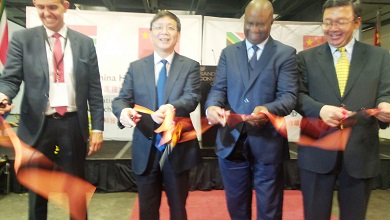 Daan du Toit, Hou Jianguo, Dr Phil Mjwara and Tian Xuejuan cut the
ribbon at the opening of the South-Africa China exhibition. The three day event aims
to enhance the two countries' collaboration. (Images: Melissa Javan)
Daan du Toit, Hou Jianguo, Dr Phil Mjwara and Tian Xuejuan cut the
ribbon at the opening of the South-Africa China exhibition. The three day event aims
to enhance the two countries' collaboration. (Images: Melissa Javan)
Reasons for the exhibition
The two countries have been cooperating on science and technology since 1999.
"The exhibition is aimed at creating a platform for South African and Chinese
science councils, academic institutions and industry players to exchange information
on new technological trends and foster collaborative linkages," said the Department
of Science and Technology.
Panel discussions were held until Saturday to bring light to research.
Development topics included:
- The benefits of herbal/plant and bio-resources to benefit the economy
for the pharmaceutical and medical industries,
- The challenges and opportunities for renewable energy in the developing world,
and;
- Advanced manufacturing.
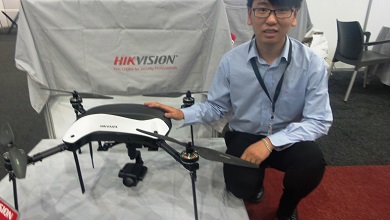 Andrew Mu, employee of the surveillance camera company Hikvision,
is one of the vendors at the exhibition. Here he is standing next to the aerial vehicle
that he said is used by the Chinese fire and police departments.
Andrew Mu, employee of the surveillance camera company Hikvision,
is one of the vendors at the exhibition. Here he is standing next to the aerial vehicle
that he said is used by the Chinese fire and police departments.
Potential to improve livelihoods in Africa
The Chinese Vice-Minister for Science and Technology, Hou Jianguo, said the
exhibition had huge potential to further
economic growth and improve livelihoods in
both countries.
He said that innovation was important for enterprise development.
Jianguo told delegates at the opening ceremony that China was always willing
to work with South Africa's young scientists and research institutions, calling this a
powerful strategy through which both countries could implement its development
objectives.
He said deepening cooperation in human capital development was critical to
growing the next generation of scientists, and that China was looking forward to
having more young people from South Africa visiting science institutions in China.
In this regard, China would train hundreds of young scientists from South Africa
over the next five years.
Dr. Phil Mjwara, director general of South Africa’s department of science and
technology said they hope to deepen the partnership between South Africa and
China. "This event will lay a basis for the exiting
partnership."
"This [event] creates a dynamic platform for networking in research and
investment."
He said an example of existing partnership is that Tshwane University is
already collaborating with China.
Mjwara also said that there's a lot of room for South African products to be
exported. "We also have a lot of products that are not here (showcased at the
event)."
The participants
There were more than 50 stalls in which the South African and Chinese
participants showcased their products or services.
Gift Lubele of GN Lub said he started his business last year when he was in
matric. "We have our first big client now."
His business transforms disposed items into products. For example, he makes
couches out of old tyres.
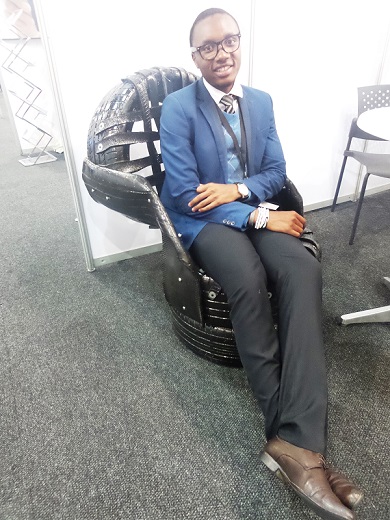 Gift Lubele believes: "If vast environmental predicaments are man made, it is the
very same man who can resolve them."
Gift Lubele believes: "If vast environmental predicaments are man made, it is the
very same man who can resolve them."
Jessica Zha and Andrew Mu, Hikvision employees, showcased its video
surveillance products.
For instance, the company’s unmanned aerial vehicles are flown into areas that
are unreachable to people. Zha said the country’s police and fire departments make
use it. "If something is wrong somewhere in the mountain, the vehicle is sent out to
view and analyse the situation.
"It can fly at 80km/h and its battery lasts for about 33 minutes," she said.
Another surveillance Hikvision camera can detect temperature. It is used on
farms and forests and sets off an alarm in the early stages of a fire, explained Zha.
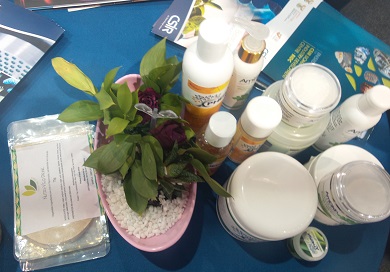 Scientists of the Council for Scientific and Industrial Research's Biosciences
division use their knowledge of indigenous plants to help people in rural
communities create products. The popular plants they have researched are the
moringa and marula.
Scientists of the Council for Scientific and Industrial Research's Biosciences
division use their knowledge of indigenous plants to help people in rural
communities create products. The popular plants they have researched are the
moringa and marula.
Zodwa Mbambo and Phatheka Mbambiso are research scientists of the Council
for Scientific and Industrial Research's Biosciences division in Pretoria. They
incorporated their knowledge of indigenous plants to develop products. These
products range from cosmetic, to medicinal, and food consumption.
For example, they created a nutritional powder breakfast drink for learners.
The ingredients include vegetables and cow pea leaves.
The powder drink is currently distributed as a pilot at five schools in the
country. The over 2 000 learners get the mixture in a packet every morning and
mix it with a cup of water.
Mbambo said they also help people in rural areas use indigenous plants to
create products. "We analyse the plant material. From the plant extract we develop
a product."
Besides doing that, these scientists test the products and help their clients
comply with the regulatory requirements. The clients are able to then sell the
products
such as lip balm, tissue oil and aqueous cream.
Mbambiso said over the past three years they have helped 19 small, medium
and micro enterprises to develop products that are commercially ready to use.
Would you like to use this article in your publication or on your website?
See Using SouthAfrica.info
material
 Daan du Toit, Hou Jianguo, Dr Phil Mjwara and Tian Xuejuan cut the
ribbon at the opening of the South-Africa China exhibition. The three day event aims
to enhance the two countries' collaboration. (Images: Melissa Javan)
Daan du Toit, Hou Jianguo, Dr Phil Mjwara and Tian Xuejuan cut the
ribbon at the opening of the South-Africa China exhibition. The three day event aims
to enhance the two countries' collaboration. (Images: Melissa Javan)
 Andrew Mu, employee of the surveillance camera company Hikvision,
is one of the vendors at the exhibition. Here he is standing next to the aerial vehicle
that he said is used by the Chinese fire and police departments.
Andrew Mu, employee of the surveillance camera company Hikvision,
is one of the vendors at the exhibition. Here he is standing next to the aerial vehicle
that he said is used by the Chinese fire and police departments.
 Gift Lubele believes: "If vast environmental predicaments are man made, it is the
very same man who can resolve them."
Jessica Zha and Andrew Mu, Hikvision employees, showcased its video
surveillance products.
For instance, the company’s unmanned aerial vehicles are flown into areas that
are unreachable to people. Zha said the country’s police and fire departments make
use it. "If something is wrong somewhere in the mountain, the vehicle is sent out to
view and analyse the situation.
"It can fly at 80km/h and its battery lasts for about 33 minutes," she said.
Another surveillance Hikvision camera can detect temperature. It is used on
farms and forests and sets off an alarm in the early stages of a fire, explained Zha.
Gift Lubele believes: "If vast environmental predicaments are man made, it is the
very same man who can resolve them."
Jessica Zha and Andrew Mu, Hikvision employees, showcased its video
surveillance products.
For instance, the company’s unmanned aerial vehicles are flown into areas that
are unreachable to people. Zha said the country’s police and fire departments make
use it. "If something is wrong somewhere in the mountain, the vehicle is sent out to
view and analyse the situation.
"It can fly at 80km/h and its battery lasts for about 33 minutes," she said.
Another surveillance Hikvision camera can detect temperature. It is used on
farms and forests and sets off an alarm in the early stages of a fire, explained Zha.
 Scientists of the Council for Scientific and Industrial Research's Biosciences
division use their knowledge of indigenous plants to help people in rural
communities create products. The popular plants they have researched are the
moringa and marula.
Zodwa Mbambo and Phatheka Mbambiso are research scientists of the Council
for Scientific and Industrial Research's Biosciences division in Pretoria. They
incorporated their knowledge of indigenous plants to develop products. These
products range from cosmetic, to medicinal, and food consumption.
For example, they created a nutritional powder breakfast drink for learners.
The ingredients include vegetables and cow pea leaves.
The powder drink is currently distributed as a pilot at five schools in the
country. The over 2 000 learners get the mixture in a packet every morning and
mix it with a cup of water.
Mbambo said they also help people in rural areas use indigenous plants to
create products. "We analyse the plant material. From the plant extract we develop
a product."
Besides doing that, these scientists test the products and help their clients
comply with the regulatory requirements. The clients are able to then sell the
products
such as lip balm, tissue oil and aqueous cream.
Mbambiso said over the past three years they have helped 19 small, medium
and micro enterprises to develop products that are commercially ready to use.
Would you like to use this article in your publication or on your website?
See Using SouthAfrica.info
material
Scientists of the Council for Scientific and Industrial Research's Biosciences
division use their knowledge of indigenous plants to help people in rural
communities create products. The popular plants they have researched are the
moringa and marula.
Zodwa Mbambo and Phatheka Mbambiso are research scientists of the Council
for Scientific and Industrial Research's Biosciences division in Pretoria. They
incorporated their knowledge of indigenous plants to develop products. These
products range from cosmetic, to medicinal, and food consumption.
For example, they created a nutritional powder breakfast drink for learners.
The ingredients include vegetables and cow pea leaves.
The powder drink is currently distributed as a pilot at five schools in the
country. The over 2 000 learners get the mixture in a packet every morning and
mix it with a cup of water.
Mbambo said they also help people in rural areas use indigenous plants to
create products. "We analyse the plant material. From the plant extract we develop
a product."
Besides doing that, these scientists test the products and help their clients
comply with the regulatory requirements. The clients are able to then sell the
products
such as lip balm, tissue oil and aqueous cream.
Mbambiso said over the past three years they have helped 19 small, medium
and micro enterprises to develop products that are commercially ready to use.
Would you like to use this article in your publication or on your website?
See Using SouthAfrica.info
material
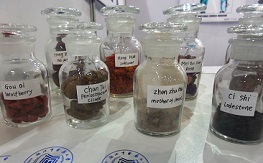 A Chinese participant at the South Africa-China exhibition in Johannesburg shows herbs used as medicine in China. The exhibition allows participants of the two countries to network and discuss how each could sell its products and services. (Image: Melissa Javan)
A Chinese participant at the South Africa-China exhibition in Johannesburg shows herbs used as medicine in China. The exhibition allows participants of the two countries to network and discuss how each could sell its products and services. (Image: Melissa Javan)




